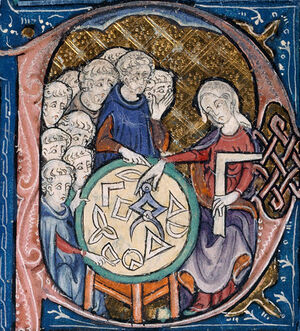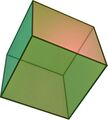Geometry (nonfiction): Difference between revisions
No edit summary |
No edit summary |
||
| Line 26: | Line 26: | ||
== Nonfiction cross-reference == | == Nonfiction cross-reference == | ||
* [[Analytic geometry (nonfiction)]] | * [[Analytic geometry (nonfiction)]] - the study of geometry using a coordinate system. | ||
* [[Doubling the cube (nonfiction)]] - also known as the Delian problem | * [[Doubling the cube (nonfiction)]] - also known as the Delian problem | ||
* [[Mathematics (nonfiction)]] | * [[Mathematics (nonfiction)]] | ||
* [[Superegg (nonfiction)]] | * [[Superegg (nonfiction)]] | ||
* [[Synthetic geometry (nonfiction)]] - the study of Geometry using the axiomatic method and the tools directly related to them (compass and straightedge) to draw conclusions and solve problems. | |||
External links: | External links: | ||
Latest revision as of 21:06, 4 January 2019
Geometry (from the Ancient Greek: γεωμετρία; geo- "earth", -metron "measurement") is a branch of mathematics concerned with questions of shape, size, volume, relative position of figures, and the properties of space.
Geometry arose independently in a number of early cultures as a body of practical knowledge concerning lengths, areas, and volumes, with elements of formal mathematical science emerging in the West as early as Thales (6th century BC).
By the 3rd century BC, geometry was put into an axiomatic form by Euclid (nonfiction), whose treatment -- Euclidean geometry-- set a standard for many centuries to follow.
Archimedes (nonfiction) developed ingenious techniques for calculating areas and volumes, in many ways anticipating modern integral calculus.
In the classical world, both geometry and astronomy were considered to be part of the Quadrivium, a subset of the seven liberal arts considered essential for a free citizen to master.
In the News
Cube to give guest lecture in mathematics class.
Fiction cross-reference
- Crimes against mathematical constants
- Forbidden Ratio
- Geometry solvent
- Gnomon algorithm
- Gnotilus
- Mathematics
Nonfiction cross-reference
- Analytic geometry (nonfiction) - the study of geometry using a coordinate system.
- Doubling the cube (nonfiction) - also known as the Delian problem
- Mathematics (nonfiction)
- Superegg (nonfiction)
- Synthetic geometry (nonfiction) - the study of Geometry using the axiomatic method and the tools directly related to them (compass and straightedge) to draw conclusions and solve problems.
External links:
- Geometry @ Wikipedia

